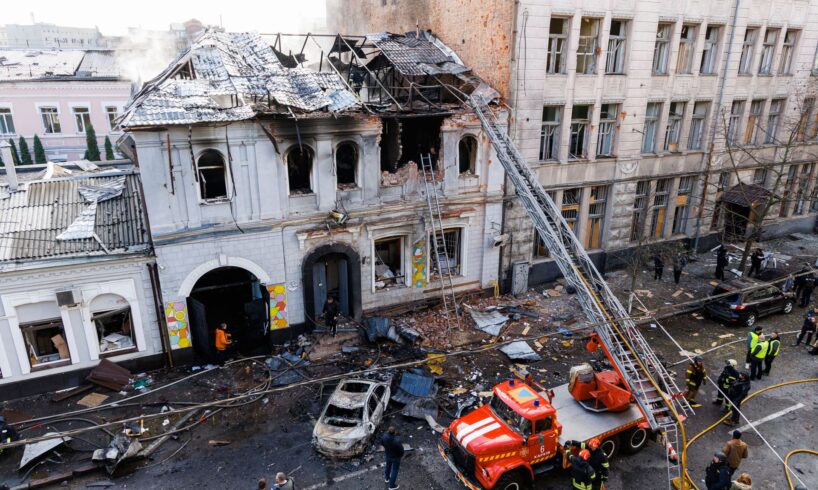
A view of the destruction as Ukrainian officials evacuate the children following the Russian drone attack on Kharkiv region of Ukraine on October 22, 2025 (Kharkiv Regional Military Adm./Anadolu via Getty Images)
On a recent voyage through Kharkiv and Kharkiv Oblast, I found myself fixating on how the region was prepping for yet another winter of Russian air attacks — one in which Russia has more aerial weapons than ever, and is already eagerly cutting off the energy supply across Ukraine.
Pre-war Kharkiv was Ukraine’s second-largest city and, for a brief moment at the start of the Soviet Union, the capital of the Ukrainian SSR. It sits just 25 miles away from Russia’s border and has long maintained a Russian-speaking population that Putin believed would eagerly lay out the red carpet for his soldiers as they marched on the city in 2022.
The city’s residents today pride themselves on having proved that belief wrong. Kharkiv city is no longer under threat of invasion, though the line in the east side of the oblast is wavering, in Kupiansk in particular.
Kharkiv itself is not under the same sort of constant violence of, say, Kherson — though a few stray FPV drones have made it into the city center in recent months. But often whatever violence Russia envisions for civilians throughout Ukraine, it tests first in Kharkiv.
Here are some of my key takeaways.
1) The best air defense is a strong air offense
The city of Kharkiv is one of the great success stories of Ukrainian air defense. It’s an odd sentiment to express while Russia is managing to turn the power off across Ukraine, but Kharkiv today is in a notably more stable condition than last spring.
A wartime hack of literally strapping wings and primitive guidance systems onto cheap Soviet bombs, glide bombs are nearly invulnerable to air defense and strike hard. Recent developments are sending them further than ever, and Russia’s stockpile remains massive.
The first time I’d found myself in Kharkiv was early 2024. At the time, Kharkiv was the preferred destination for Russian glide bombs. Outside of the very center, electricity was an intermittent luxury. The northern outskirts in particular ran exclusively on generators, whose buzz and exhaust filled the spring air.
Yet today the number of glide bombs falling on Kharkiv has plummeted. Electrical outages pass through the city in routine shifts, and for now they’re running on announced schedules and lasting a relatively manageable stretch of time.
Upon asking around, the reason for this aerial success becomes clear: The Ukrainian military started blowing up the airfields and planes that launch those bombs.
Thanks to a combination of greater Ukrainian strike technology and the rollback of Western restrictions on the use of donated weapons — in particular U.S.-made HIMARS and ATACMS — on sites inside of Russia, Ukraine has managed to nip many potential air attacks on Kharkiv in the bud.
2) Russia is targeting hospitals and fire departments in the region
The skies of Kharkiv are certainly still dangerous. Russia’s choice of targets is growing increasingly nefarious.
In one instance, around 11 a.m., the distinct moped rumble of a Shahed-type drone broke through the fog hanging over one of Kharkiv’s central squares well before you could catch sight of its isosceles wings.
That Shahed passed by on its way southwest. As the drone crashed down on what turned out to be a kindergarten about two kilometers away in the neighborhood of Kholodnohirsky, you could see the shockwave from under the terrace of the largely derelict opera house in the middle of the square. Two others repeated the exact same route and strike zone.
Fortunately the kids had gone into their underground shelter and all survived — in contrast to a number of adults injured and one killed in the café next door.
The intrepid Nick Allard managed to capture the eerie interior of the schoolroom, where the roof had caved in and was smoldering next to a knee-high dining table surrounded by multi-colored chairs where the children’s lunches still sat.
Russian air strike on a kindergarten in Kharkiv, Ukraine on Oct. 22, 2025. (Nick Allard / The Kyiv Independent)
Russian attacks on civilian infrastructure are nothing new. Nor even is the chronic threat of “double-taps,” in which Russian forces launch air strikes on targets they had hit a half-hour to an hour before — a tactic to murder firefighters and paramedics who have made their way to the scene of an initial attack.
More recently Russia has begun targeting the origin points of the emergency services themselves. That includes fire stations and hospitals. Fire stations have instituted sweeping new security protocols which sees them more sequestered from the public eye.
Kharkiv Oblast’s military administration is, meanwhile, campaigning to build an underground hospital. Underground schools have long been a routine part of Kharkivan life but can be held in spaces as small as a storefront in a perekhid, one of Ukraine’s underground walkways.
3) Last-mile drone workshops are getting bigger
Among other tightly guarded and often underground infrastructure throughout Kharkiv Oblast, is an ever-expanding network of last-mile drone workshops.
Such workshops are distinct from the larger factories that mass-produce drones. Most of those factories are in Ukraine’s interior or concentrated near the western borders.
But every military unit of scale has workshops nearer to the zero line where they reconfigure drones right before sending them to the front. Exploring some of these around Kharkiv today, they are growing to the size of some actual manufacturers’ floorspace back in 2023.
Ukrainian soldiers of the Black Wing unit, 116th Mechanized Brigade, build FPV drones at a workshop facility in an undisclosed location near the front line of eastern Ukraine, Kharkiv region, on October 8, 2025 (Ed Jones/AFP via Getty Images)
Khartiia, for instance, likely the most visible brigade in the Kharkiv sector, showed us a drone lab that extended multiple stories underground, with intricate ventilation and power supplies that was a far cry from the sorts of improvised sheds of earlier in the war.
The primary task remains the same, however. Namely, installing the latest communications and connections modules — directional antennae, transceivers, and often just re-soldering sloppy contacts — so drones can more or less function in the latest waves of Russian electronic warfare.
4) Kharkiv is rebuilding in places you wouldn’t expect
Aboveground, despite continued danger, Kharkiv Oblast is hosting an impressive level of rebuilding. Even Izium, reconquered from Russian occupation in 2022, is startlingly lively these days, though much of that activity is as a last stop for soldiers en route to one of several fronts.
Russian forces were at the city of Kharkiv’s doorstep back in 2022. The north side of the city still hosts a landscape of massive Soviet apartment blocks that shelling at the time destroyed, or at least rendered barely inhabitable.
Even amid that veritable graveyard, new buildings have not only gone up, but are already operational. “Reconstruction” as a term lost a lot of its heft sometime in 2023, as people gave up on a quick Ukrainian counteroffensive and consequent end to war, but Kharkiv is actively building back at least some of what it lost.
5) The relationship between the brigades and governmental authorities is chaotic
A recent change-up in military command to a “corps” rather than brigade structure seems to have taken even the soldiers who fell under it by surprise. The infrastructure of the local operational-strategic grouping (OSUV) was still in action, despite a new local command theoretically running the show.
Many of Ukraine’s military brigades have historically enjoyed a degree of autonomy that verges on fiefdomery. They also get a unique political microphone when wartime politics often stigmatize political dissent.
And indeed characters like Mykhaylo Drapatyi, a popular command leader who had to resign in June, seem to have a unique resilience, despite drawing the ire of Commander-in-Chief Oleksandr Syrskyi.
Complicating the situation is an underlying tension between city mayors, who are locally elected, and oblast governors, who are political appointees.
In the case of Kharkiv and Kharkiv Oblast, that puts Mayor Ihor Terekhov and Governor Oleh Syniehubov in an ongoing competition for hearts and minds and, at times, information.
One critical shortage keeps Ukraine’s interceptor drones from blocking out Russia’s Shaheds
October is coming to an end and as winter approaches, many Ukrainians find themselves more vulnerable than ever in the face of mounting Russian air attacks. In Kyiv, Russian combined missile and drone attacks routinely result in mass casualty events. Smaller-scale drone attacks which occur on a near-nightly basis have until recently posed much less of a threat. But overnight on Oct. 26, three people were killed and 32 others — including three children — were injured when two multi-story reside





